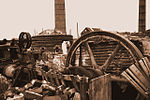Woodville, Derbyshire
Civil parishes in DerbyshireEngvarB from July 2016South Derbyshire DistrictVillages in Derbyshire

Woodville is a suburban village and civil parish that crosses two districts - South Derbyshire district of Derbyshire and North West Leicestershire district of Leicestershire, England, 2 miles (3.2 km) east of Swadlincote. At the 2011 Census, the parish had a population of 5,161, an increase from 3,420 at the 2001 Census. The centre of the village, known as the Tollgate, is a busy traffic island on the A511. Woodville forms part of the border with Leicestershire.
Excerpt from the Wikipedia article Woodville, Derbyshire (License: CC BY-SA 3.0, Authors, Images).Woodville, Derbyshire
High Street, South Derbyshire
Geographical coordinates (GPS) Address Nearby Places Show on map
Geographical coordinates (GPS)
| Latitude | Longitude |
|---|---|
| N 52.769 ° | E -1.533 ° |
Address
High Street
High Street
DE11 7EH South Derbyshire
England, United Kingdom
Open on Google Maps










